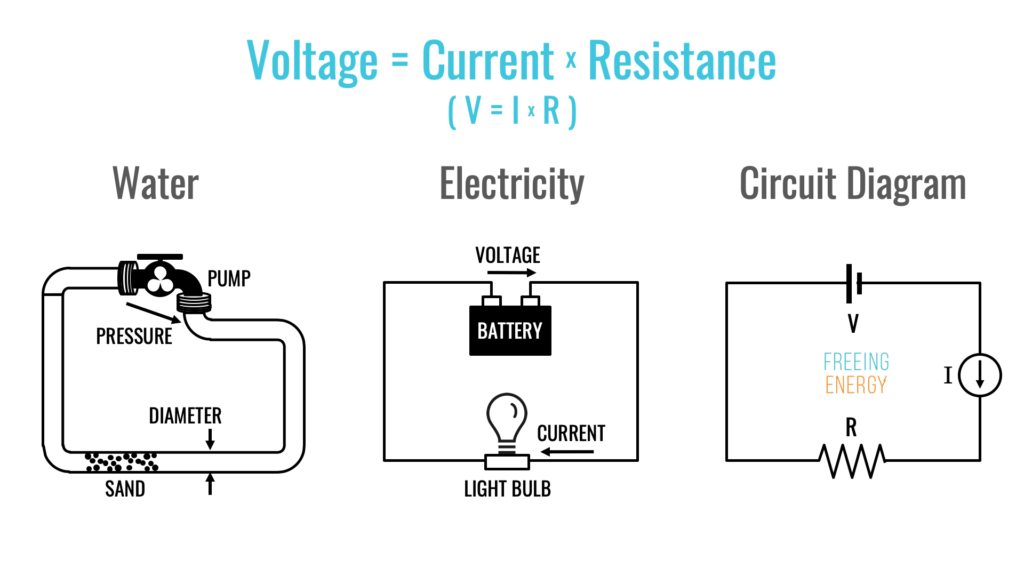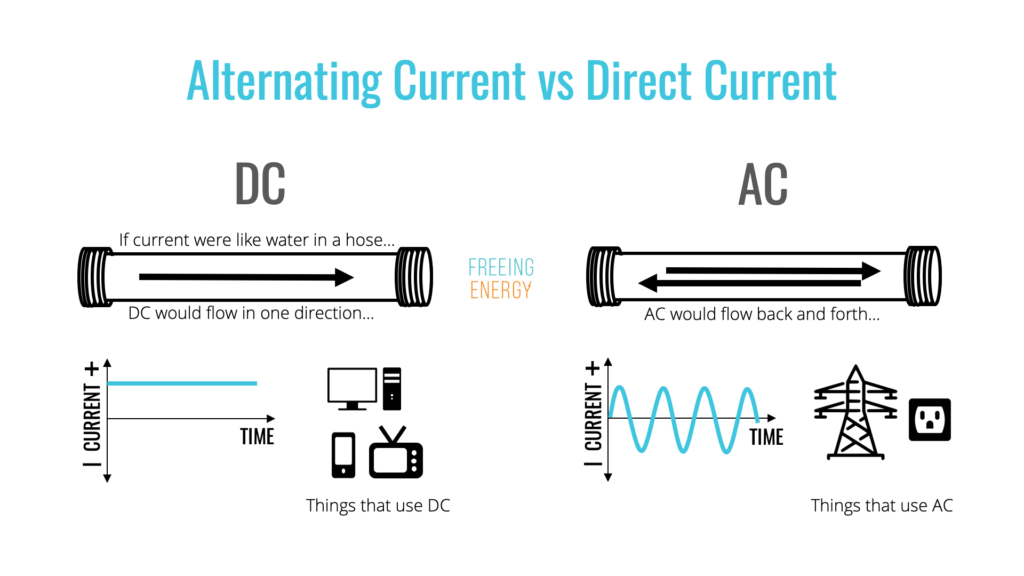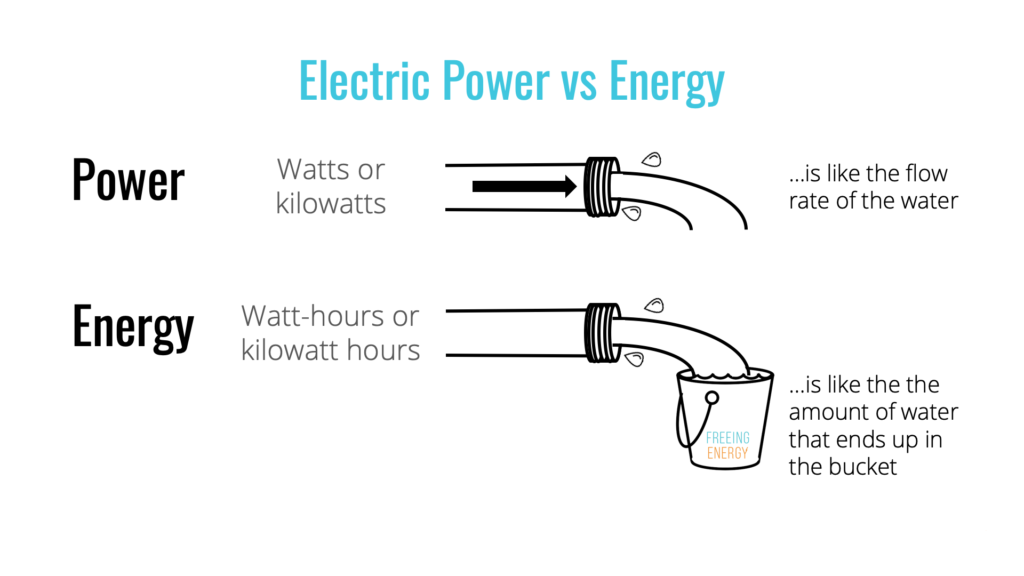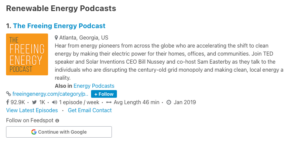“We believe that electricity exists because the electric company keeps sending us bills for it. But we cannot figure out how it travels inside wires.” — Dave Barry
The fundamental laws of electricity are mathematically complex. But using water as an analogy offers an easy way to gain a basic understanding.
Electricity 101 – Voltage, Current, and Resistance
The three most basic components of electricity are voltage, current, and resistance.
- VOLTAGE is like the pressure that pushes water through the hose. It is measured in volts (V).
- CURRENT is like the diameter of the hose. The wider it is, the more water will flow through. It is measured in amps (I or A).
- RESISTANCE is like sand in the hose that slows down the water flow. It is measured in ohms (R or Ω).
Voltage, current, and resistance are all related. If you change one of them in a circuit, the others will change, too. Specifically, voltage is equal to current multiplied by resistance (V = I x R). Thinking about water, if you add sand into the hose and keep the pressure the same, it’s like reducing the diameter of the hose… less water will flow.
Electricity 201 – DC, AC, Batteries, and Transformers
How does electricity work in electronics and the grid?
DIRECT CURRENT or DC is similar to the normal flow of water in a hose – it flows in one direction, from the source to the end. Historically, DC was originally championed by Thomas Edison in the famous Current Wars of the late 1800s. DC lost the war for the grid but it has found an even more exciting role in modern electronics like computers, phones, and televisions.
GET MONTHLY NEWS & ANALYSIS
Unsubscribe anytime. We will never sell your email or spam you.
ALTERNATING CURRENT or AC is like the water flowing back and forth within the hose many times per second. The water analogy breaks down a little here but AC is easily created by electric generators (also called alternators). Nikola Tesla and George Westinghouse championed AC over DC and they eventually prevailed. AC is now the global standard for delivering electricity to homes and buildings via the grid.
BATTERIES can be thought of as water pumps that circulate water through a hose that travels in a closed loop back to the battery. There are many metrics used for the capacity of batteries and not all are immediately logical. They include amp-hours and kilowatt hours. Batteries can only generate DC power.
TRANSFORMERS are like holding your thumb partially over the end of the hose to get the water to spray farther. The water volume (power) remains the same but the pressure (voltage) increases as the diameter (current) decreases. This is exactly what transformers do for overhead powerlines. The electricity can travel farther with fewer losses because the resistance (sand) doesn’t impede the electricity (water) when the current is lower (smaller diameter hose). Transformers only work with AC. The ability to move electricity over long distances is the main reason AC beat out DC a century ago.
Electricity 301 – Power and Energy
Now, let’s keep using the hose analogy to dive into the murkier waters of circuits (pun intended, sorry).
POWER is like the volume of water that is flowing from the hose, given a specific pressure and diameter. Electric power is measured in watts (W). And larger systems are measured in kilowatts (1 KW = 1000 watts) or megawatts (1 MW = 1,000,000 watts).
ENERGY is like measuring the volume of water that has flowed through the hose over a period of time, like filling a 5 gallon bucket in a minute. Electric energy is often confused with electric power but they are two different things – power measures capacity and energy measures delivery. Electric energy is measured in watt hours (wh) but most people are more familiar with the measurement on their electric bills, kilowatt hours (1 kWh = 1,000 watt hours). Electric utilities work at a larger scale and will commonly use megawatt hours (1 MWh = 1,000 kWh).
Hopefully, this offers a helpful introduction to the basics of electricity. We’d love to hear your feedback and suggestions, so please leave suggestions and comments below.








35 Responses
This is a great explanation. I wish my physics classes had used this in my undergraduate degree. As a mechanical engineer, this is more intuitive to me. Thanks!
This is good learning exposure by understanding basic knowledge about electric power for those who has different technical background. Thanks.
An important refinement of the concept presented in the sentence: “Transformers only work with AC” follows.
A transformer, handling square wave AC, together with a number of fast, inexpensive electronic switches, can do for DC, what a simple transformer does for AC. This combination circuit is smaller, lighter, and less expensive, than the sine wave AC transformer that it displaces. Before fast cheap electronic switches, An AC transformer immediately followed the fuse and power switch in all high quality electronic instruments, like radios and TV sets. Now, all of those transformers are gone, because creating numerous new DC voltage levels is cheaper and easier, using switching circuits.
Your article fails to mention that really serious, modern power lines, for many megawatts over hundreds of miles, like the Pacific Intertie, revert to DC to avoid skin effect losses, and losses due to imperfect, and expensive, power factor correction circuits.
My hope is that underdeveloped countries will never need to interpose the difficulties of sine wave AC, between their solar, and fuel cell DC sources, and their LED and other DC loads.
Free electrical energy from sine waves, while freeing it from the utilities that employ them!
The writer’s intention was to explain electricity in the simplest possible way he could and he achieved that. Your point is also important but more advanced explanation. Can you pls try to explain your assertion in a simple fashion as the author of this article did.
Thanks
Fantastic idea of using water flow system to explain the electricity in simple manner.
Thanks for your explanation. Having little knowledge of electricity, I have tried to liken the basics to waterflow in my minds eye. This analogy has defined that concept so well. It shows simplicity can sometimes be actually simple.
The expose was simple , easy to comprehend. Thank you very much
Equating hose diameter to electrical current seems wrong to me.
I think this Wikipedia article is a better starting point : https://en.wikipedia.org/wiki/Hydraulic_analogy
Thanks a bunch for sharing the thoughts I had never seen this Wikipedia article. FWIW, I initially wrote this as you describe but when I expanded the article to include power and energy, I had to modify the analogy to differentiate between current and energy.
Very helpful post. Thanks to give us such an amazing blog.
It’s quite interesting the analogy used to explain electricity
This has completely explained Electronics to me!! Thank you!!
Thank you Bill for the article, It was fun reading it and easy to understand, as mentioned above by another reader, if these concepts were thought in school, it would have been very easy to grasp – Thank you once again.
explained very well,found it easy to understand.
Thank you for taking the time to teach others simply.
In the simplified water & hose analogy for understanding how electricity works, where do WATTS come in? I still
don’t have a completely clear picture. Thx.
Watts are a form of power, which is presented in the “301” section. Watts are like the flow of water.
Loved The analogy! Now I can see this in my head, and understand what’s happening. Much appreciated! Now, when you have a 2000watt inverter in a RV, how do you figure out how long that will last with 120 volt appliances (ie: lights, tv, coffee pot, & refrigerator). How do you compute that?
Watts are a measure of instantaneous electricity so a 2000W inverter only tells you how BIG of an appliance it can run but it doesn’t say anything about how long it can run that appliance. Most appliances will have their wattage in the instruction manual so you should be able to figure out which combination of appliances would exceed the inverter’s capacity and cause its circuit breaker or fuse to blow. Hope this helps.
This is very helpful, the way you have put it even a dummy like me understood?
How would you explain inductance using water analogy ?
That is an excellent question! I will have to ponder that. If anyone else here on the forum has ideas, please chime in!
The analogy used here is poor in regards to electrical current being like the diameter of the hose. Your analogy implies that we can increase current by increasing the hose diameter, which is misleading.
The diameter of the hose determines the *maximum* current that the cable can handle, but it does not determine how much will flow – unless the cable is either too narrow a diameter, too long, or both.
The diameter and length of the hose is simply another resistance, as it slows the flow of water. A load, such as a lightbulb, would act as a further restriction on the hose (sand, or someone stepping on the hose, etc) and further limit current flow.
The current that flows is simply how much water moves through the hose, as a resultant of the pressure (voltage) and the total resistance in the circuit.
If you make the hose larger and larger, without changing the resistance of the load, current will stay the same. If the hose gets smaller and smaller (or longer and longer), at some point, the diameter of the cable will become a notable restriction to flow. When this happens with electrical current, the cables begin to heat notably. In a well designed system, the resistance of the cabling should be insignificant compared to the amount of current the load consumes.
electric energy is like the definite integration of electric power
Thankyou.
Quite beautifully explained.
Would love to see more on this
I want to power my laptop and WiFi router by using a 500w inverter and a 110 amp hour deep cycle / leisure battery would this equipment be sufficient for my requirements
Regards
Martin
VOLTAGE is like the pressure that pushes water through the hose. It is measured in volts (V).
CURRENT: the water flowing in the hose is current. It is measured in amps (I or A).
RESISTANCE is like the diameter of the hose. The wider it is, the more water will flow through.. It is measured in ohms (R or Ω).
Absoluetly genius way of explaining the concept.. Thanks!!
Woow that’s so Fantastic……
I explained this to my pupils and they got the concept really fast..with very interesting questions to go with
Thank you
While everyone’s comments are awesome, we need to remember this article is not made to make an engineer it is to give anyone who is interested in electricity a very basic understanding. As some people might not be as advance in electricity or electronics as some of you might be I feel that this was a good way to explain how they work. So thank you for the explanation and I look forward to reading other articles that you might writte.
very intresting,need more of this on electrical appliances like meter/ct meter
Thank you all. This’s a nice article that has accomplished the author’s intention. I have some knowledge in electricity (mostly non-practical), but i have a degree in computers. If an Electrical Engineer in this board can respond, i have a question that has lingered in my mind: for example in a small town’s power grid; do the overall power grid wires form a loopback to the power station that generates the whole electricity of this small town? i need to understand where the flow of electrons end but thought that they never end since the whole power grid is a loopback, & electrons shed by the atoms in the copper wire just keep circling inside the whole grid wires back & forth to the power station itself.
Second question: since most of resistance in a circuit is created by a load (like a light bulb), can we use a sponge analogy instead of sand in the waterpipe? I thought the sponge absorbs more water than sand while also empeding water flow. Thanks again.